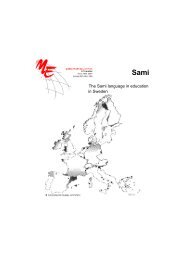Multilingual Early Language Transmission (MELT) - Mercator ...
Multilingual Early Language Transmission (MELT) - Mercator ...
Multilingual Early Language Transmission (MELT) - Mercator ...
Create successful ePaper yourself
Turn your PDF publications into a flip-book with our unique Google optimized e-Paper software.
Finland has the last 20 years experienced increased immigration. The immigration to Finland<br />
is still very small in comparison to most other European countries, but for Finland the<br />
increased immigration has had a significant impact on, for example, educational policy.<br />
Approximately half the immigrants to Finland settle in the Helsinki metropolitan region.<br />
Most of the immigrants become Finnish speakers but there is substantial interest among<br />
Swedish politicians to increase the number of immigrants who become Swedish speakers<br />
and whose children will thereby attend Swedish schools. This would also decrease the risk<br />
that the Swedish speaking community would become isolated from the general societal<br />
trend of increasing diversity. Altogether about 8% of children younger than 7 are of<br />
immigrant background in the Helsinki metropolitan region (Advisory board of early<br />
childhood education and care, 2008).<br />
Finland as a country is quite nature oriented and the daycares and their activities are often<br />
connected to nature in many ways. However, this is a bit more difficult in the bigger cities.<br />
On the other hand the cities have a larger palette of cultural activities and resources. This is<br />
an aspect that we want to take advantage of in our program.<br />
The first theme, multilingualism, consists of three subthemes namely bi- and multilingualism,<br />
language immersion programs, and language stimulation activities. The language immersion<br />
program part of the program is left to be developed later. The multilingualism and the<br />
language stimulation go hand in hand. The most current research on bilingualism strongly<br />
supports early language learning (see, for example, the work of Judith Kroll; Janet Werker;<br />
Linda Bialystok). In the Swedish daycare centers bilingualism is a part of daily life and the<br />
teachers need to know how to stimulate the bilingual children’s Swedish skills which can be<br />
very weak. The daycare center is many times the only completely Swedish speaking<br />
environment in a child’s life. Interestingly it is not enough for the teachers who in many<br />
cases themselves have weak Finnish skills to know how to support the children’s language<br />
because they also have to have fairly good Finnish skills in order to communicate with<br />
parents who maybe speaking only Finnish. Therefore most of the teacher education students<br />
will take their minor subject in Finnish. This way they not only improve their own Finnish<br />
skills but they also become exposed to the Finnish way of thinking about early childhood<br />
education. This connects also to the second theme identity and diversity.<br />
This theme consists of multicultural education, gender and the Swedish culture in Finland.<br />
The identity as a Swedish speaking Finn is an interesting subtheme in the sense that the<br />
program has an expanded notion of what it might mean to be a Swedish speaker.<br />
Traditionally it has meant that a person is a Swedish speaker and comes from a Swedish<br />
speaking family. However, due to the changing language picture it is important for the<br />
bilingual children as well as those with Finnish as their mother tongue to feel that they are<br />
part of the Swedish speaking community if they so choose. The goal is for the children to<br />
develop a solid Swedish identity without being excluding of others. Here it could be argued<br />
that the goal is a cosmopolitan attitude where one’s own identity is clear but open for<br />
impulses from others in a globalizing and diverse world (Mansikka & Holm, 2011). The goal is<br />
that through multicultural education foster an inquiring and accepting way of looking at<br />
diversity.<br />
The concept multicultural is for this program an inclusive concept in the sense that it does<br />
not only refer to race and ethnicity but also includes gender, social class, religion, disability<br />
and sexual orientation. We have particularly lifted gender to the forefront since gender<br />
stereotyping is quite strong still in Finland and girls and boys perform quite differently in<br />
school as canbe seen in, for example, the recent PISA results (Sulkunen, Välijärvi, Arffman,<br />
Harju-Luukkainen. Kupari, Nissinen, Puhakka & Reinikainen, 2010). However, this does not<br />
116



